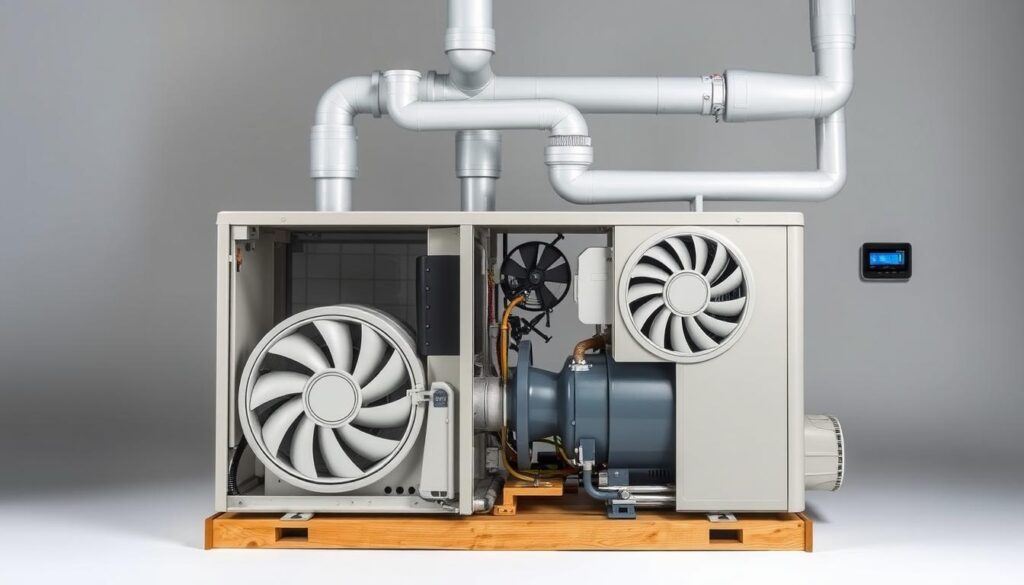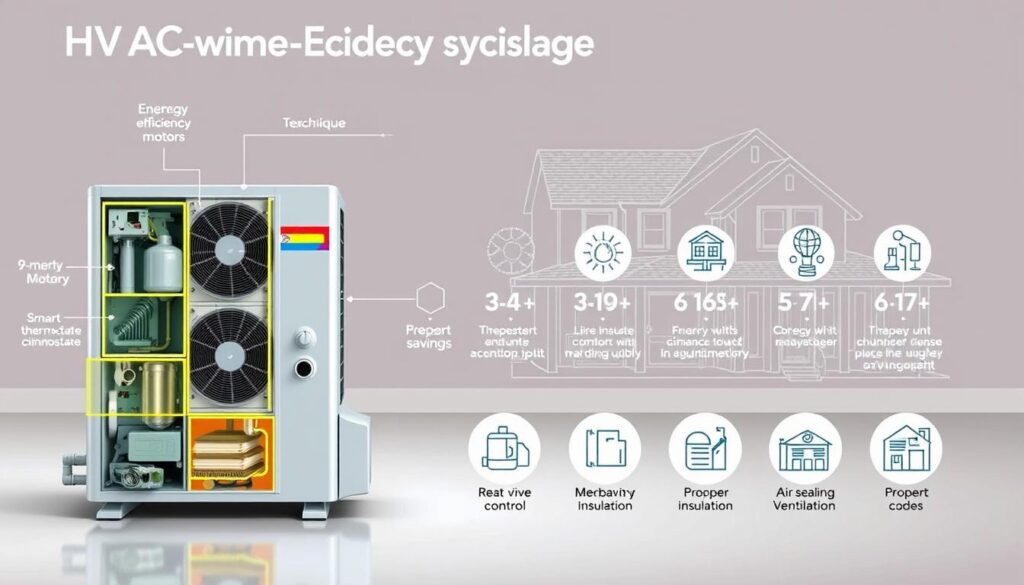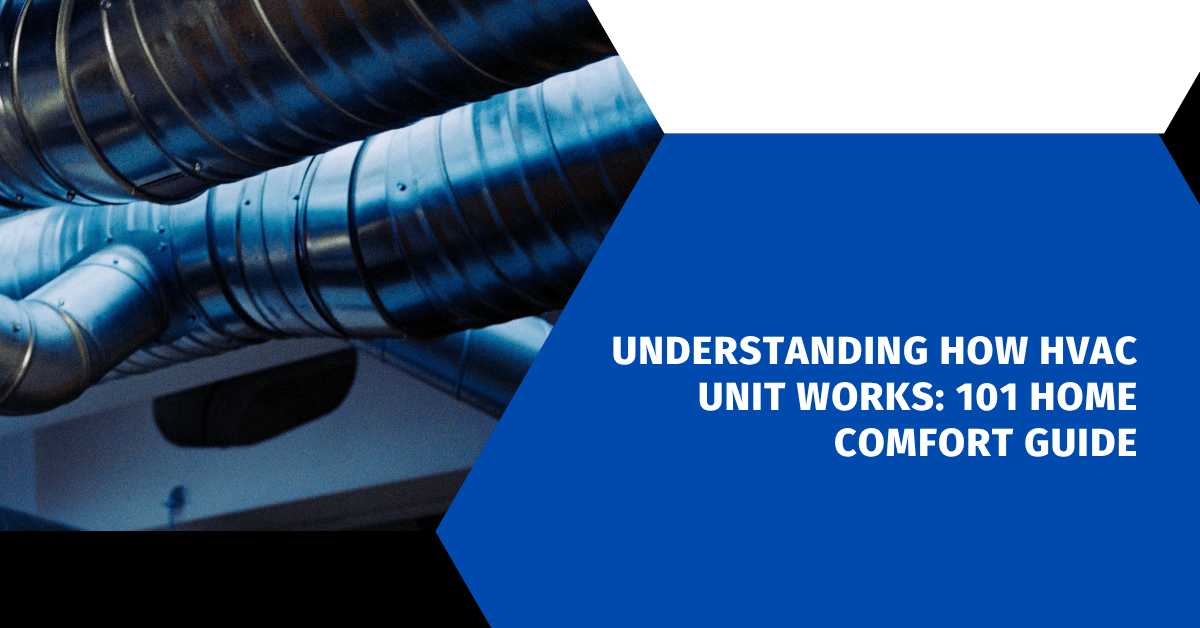Affiliate Disclosure
HVAC Guide Guys is a participant in the Amazon Services LLC Associates Program, an affiliate advertising program designed to provide a means for sites to earn advertising fees by advertising and linking to Amazon.
Understanding How HVAC Unit Works? Ever wondered how your home stays just right all year? It’s thanks to the hard work of HVAC systems. They work quietly to keep you cozy.

An HVAC system does more than just control the temperature. It’s a complex mix of parts designed to keep your home comfy all year. It warms you up in winter and cools you down in summer. The way it works is both amazing and essential for your comfort.
Today’s HVAC parts are made to create the perfect indoor climate. They do more than just adjust the heat. They also control humidity, clean the air, and make sure your home is a cozy haven, no matter the weather outside.
Key Takeaways
- HVAC systems provide complete home climate control
- Works all year for heating and cooling
- Has a complex network of parts
- Manages temperature, humidity, and air quality
- Key for keeping your home comfy and healthy
Table of Contents
The Fundamentals of HVAC Systems
Your home’s comfort depends on a network of technologies. HVAC systems are key, working quietly to keep you cozy through the seasons.
An HVAC system is more than a machine. It’s a climate control solution that manages your home’s temperature, humidity, and air quality. These systems are vital for your comfort and health, affecting your daily life.
Definition and Basic Functions
An HVAC system has three main jobs:
- Heating your home in the cold months
- Cooling it when it’s hot
- Keeping the air quality good
Role in Home Climate Control
Your HVAC unit works hard to make your home comfortable. It can remove up to 95% of indoor pollutants. These systems do more than just control the temperature.
Modern HVAC systems aim to boost your home’s comfort and save energy.
Primary System Components
To understand how an HVAC unit works, you need to know its main parts. Here’s a list of the essential elements:
| Component | Primary Function | Efficiency Impact |
|---|---|---|
| Thermostat | Temperature Control | Can reduce energy costs by 5-15% |
| Furnace | Heating | Key for winter comfort |
| Air Conditioner | Cooling | Controls temperature and humidity |
| Ventilation System | Air Quality Management | Removes up to 95% of pollutants |
Learning about your HVAC system can save you a lot of money and make your home more comfortable. First-time homeowners might cut their electric bills by up to 30% by optimizing their HVAC system.
How HVAC Unit Works: Components and Operation
It’s important to know how an HVAC unit works to keep your home comfortable and energy-efficient. Your HVAC system has many parts that work together. They control temperature, humidity, and air quality in your home.
The main parts of an HVAC unit are the heating and cooling systems. A typical system has two main parts:
- Outdoor unit with condenser coil and compressor
- Indoor evaporator coil that controls temperature
The refrigeration cycle is key to cooling your home. Refrigerant moves between the outdoor and indoor units. It absorbs and releases heat to keep your home at the right temperature.
“Your HVAC system is like the lungs of your home, constantly breathing and regulating internal conditions.”
Heat pumps are important for heating your home. They can take heat from outside air, even when it’s very cold. This makes them great for controlling the climate all year.
| HVAC Component | Primary Function | Key Characteristic |
|---|---|---|
| Compressor | Pressurize Refrigerant | Enables Heat Transfer |
| Evaporator Coil | Absorb Indoor Heat | Supports Cooling Process |
| Condenser Coil | Release Absorbed Heat | Outdoor Heat Rejection |
Keeping your HVAC system in good shape is essential. Change filters every two months and get a professional check-up once a year. This will help your system work better and last longer.
Essential Components of Your HVAC System
Knowing the main parts of your HVAC system is key for keeping your home comfy and energy-efficient. Each part is vital for heating, cooling, and controlling your indoor climate. From smart thermostats to complex mechanical systems, they all work together for a smooth temperature control.
Today’s HVAC systems have many important parts that work together to manage your home’s temperature and air quality. Let’s look at the main elements that make your heating and cooling system work well.
Thermostat and Control Units
The thermostat is the brain of your system. Smart thermostats have changed how we manage our home’s climate. They offer features like:
- Geofencing technology
- Smartphone location-based adjustments
- Programmable scheduling
- Energy consumption tracking
Furnace and Heat Exchanger
Your furnace is key for heating your home. It’s important to get it checked every year. This is because 90% of carbon monoxide poisoning cases are caused by bad furnaces.
| Furnace Component | Key Function | Maintenance Recommendation |
|---|---|---|
| Heat Exchanger | Transfers heat from combustion | Inspect annually |
| Blower Motor | Circulates heated air | Check for efficiency |
Air Conditioning Components
Air conditioning systems have important parts to cool your home well. The evaporator and condenser coils are key for absorbing and releasing heat.
Modern air-source heat pumps can work in temperatures as low as 0 degrees Fahrenheit. They offer flexible heating and cooling solutions.
By knowing these HVAC system parts, you can keep your system running well. This improves energy use and keeps your home comfortable.
Explore Our HVAC Shop
Looking for top-rated HVAC tools, parts, and accessories? Visit our shop and find the perfect solution for your needs.
Visit the ShopUnderstanding the Heating Process
Your HVAC heating process is a complex system that turns cold air into warm comfort. It uses a series of components to heat your home efficiently.
Gas furnaces are the top choice for heating homes. They work by turning fuel into heat in a precise way:
- Fuel ignition in the combustion chamber
- Heat transfer through the heat exchanger
- Warm air distribution via ductwork
“The heart of heating is not just generating warmth, but distributing it effectively throughout your living space.” – HVAC Professional
When your thermostat notices a drop in temperature, the furnace starts its heating cycle. The heat exchanger is key here, making cold air warm and cozy.
| Heating Component | Primary Function | Temperature Range |
|---|---|---|
| Fuel Combustion Chamber | Generate Initial Heat | Up to 120°F |
| Heat Exchanger | Transfer Thermal Energy | 50-150°F |
| Blower Motor | Distribute Heated Air | Room Temperature |
Different furnaces are better in different conditions. Heat pumps work well in many temperatures. Gas furnaces are best in very cold places below 50°F.
Explore Our HVAC Shop
Looking for top-rated HVAC tools, parts, and accessories? Visit our shop and find the perfect solution for your needs.
Visit the ShopThe Cooling System Mechanism
Learning about the hvac cooling process helps us see how our homes stay cool in summer. Your HVAC unit uses a complex system to make warm air cool and refreshing.
Refrigeration Cycle Explained
The refrigeration cycle is central to how HVAC units function. It involves several key steps:
- Refrigerant enters the compressor as a low-pressure gas
- Compression raises the refrigerant’s temperature and pressure
- Hot refrigerant moves to the condenser coil
- Heat is released outside, transforming refrigerant into a liquid
- Expansion valve reduces refrigerant pressure
Heat Transfer Dynamics
Your HVAC system uses heat transfer to cool your home. It pulls warm air through the evaporator coil. Refrigerant absorbs indoor heat, cooling the air before it’s circulated back.
“The magic of cooling is not about adding cold, but removing heat” – HVAC Engineering Principle
Humidity Control Mechanism
Your HVAC unit also controls humidity. As air cools over the evaporator coil, moisture condenses and drains. This makes your home more comfortable.
Understanding these processes shows us the amazing engineering behind keeping our homes cool and comfy, even on the hottest days.
Explore Our HVAC Shop
Looking for top-rated HVAC tools, parts, and accessories? Visit our shop and find the perfect solution for your needs.
Visit the ShopAir Distribution and Ventilation Systems

Your home’s HVAC air distribution system is a quiet hero. It keeps your living space comfy. These networks of ducts and vents work hard to move air around your home. They make sure every room is just right.
Ductwork is key in your HVAC system. It carries heated or cooled air from your unit to rooms. These hidden paths are made from:
- Galvanized sheet steel
- Aluminum
- Flexible duct materials
Good air distribution depends on a few things. Round ducts are about 30% more efficient than square ones because they have less resistance to airflow. The right duct design can also clean the air better by filtering out pollutants.
“A well-designed ventilation system is the lungs of your home, breathing life into every corner.”
Knowing about your home’s air system helps keep it comfy. Return air ducts near the floor help air mix better. Balanced airflow stops negative pressure that can hurt your HVAC’s work.
Keeping your hvac air system in check means:
- Even temperatures in all rooms
- Better air quality
- More energy savings
Spending time on your home’s air network pays off. You’ll enjoy better comfort, save on energy, and breathe easier.
Modern HVAC Technologies and Features
Today’s HVAC technologies are changing how we enjoy our homes. They make managing our home’s climate easier and more efficient. These systems bring new levels of comfort and convenience.
Smart home tech has made controlling your home’s temperature better than ever. These systems do more than just set the temperature. They offer a new way to manage your home’s climate.
Smart Thermostat Integration
Smart thermostats are a big step forward in saving energy. They learn your habits and adjust the temperature for you. This can cut energy use by up to 15%.
- Remote temperature control via smartphone apps
- Occupancy-based temperature adjustments
- Energy usage reporting and insights
- Integration with other smart home devices
Energy-Efficient Solutions
Modern HVAC systems focus on saving energy. They use variable-speed compressors and advanced filters. This makes them more efficient and saves money on energy bills.
| Technology | Energy Savings | Key Benefit |
|---|---|---|
| Variable-Speed Compressors | 30-50% | Adaptive Performance |
| Smart Thermostats | 10-15% | Intelligent Control |
| Advanced Filtration | Air Quality Improvement | 99.97% Particle Capture |
Zoning Capabilities
Zoning systems let you control the temperature in different parts of your home. By creating separate climate zones, you can enjoy your home more while saving up to 30% on energy.
“Smart HVAC technologies are not just about comfort—they’re about intelligent, efficient home management.” – HVAC Industry Expert
Common Types of HVAC Systems
Knowing about the different HVAC systems helps you pick the best for your home. Modern HVAC parts vary a lot. Each type has its own benefits for different homes.
- Split Systems: The most common residential setup
- Packaged Units: All-in-one solutions
- Ductless Mini-Split Systems: Flexible zonal heating and cooling
- Hybrid Systems: Mixes different heating methods
Split systems are the top choice for homes. They have an outdoor unit and an indoor air handler. This makes a strong HVAC network.
| System Type | Key Characteristics | Best Use Case |
|---|---|---|
| Split System | Separate indoor/outdoor units | Most residential homes |
| Heat Pump System | Heating and cooling abilities | Mild to moderate climates |
| Ductless Mini-Split | No ductwork needed | Targeted room cooling |
| Packaged Unit | All parts in one cabinet | Smaller homes/buildings |
“Choosing the right HVAC system is about matching your specific comfort needs with technological efficiency.” – HVAC Industry Expert
When picking your system, think about climate, home size, energy efficiency, and maintenance costs. Heat pumps are growing fast in the market. They work well in many temperatures.
Explore Our HVAC Shop
Looking for top-rated HVAC tools, parts, and accessories? Visit our shop and find the perfect solution for your needs.
Visit the ShopEnergy Efficiency and Cost Management
Learning about hvac energy efficiency can really help your home feel better and save money. Homeowners spend a lot on heating and cooling. These systems use about half of all household energy.

To get the most from your HVAC, you need smart strategies. It’s not just about buying the right equipment. It’s also about how you use and care for it.
Seasonal Energy Efficiency Ratio (SEER)
The SEER rating shows how well your air conditioner cools. A higher SEER means better energy use. Here are important things to think about when choosing your HVAC:
- ENERGY STAR certified systems can lower your energy bills by 10-30%
- New, efficient systems can cut energy use by up to 50%
- Getting it installed right is key for top performance
Cost-Saving Operations
There are smart ways to cut down on your HVAC costs:
- Keep it maintained to avoid waste
- Use smart thermostats to control temperature better
- Seal your ducts to stop air leaks
“Investing in energy efficiency is investing in long-term savings” – HVAC Industry Expert
| Efficiency Strategy | Potential Energy Savings |
|---|---|
| Replacing old systems | Up to 50% |
| Proper duct sealing | 20% reduction in energy loss |
| Regular maintenance | 10-15% efficiency improvement |
By knowing these tips, you can make your HVAC work better and save money.
Maintenance Requirements and Best Practices
Keeping your HVAC system in top shape needs regular care. It’s key to avoid sudden breakdowns and keep it running well. By following important hvac maintenance tips, you can make your system last longer and save on energy.
“Proactive maintenance is the key to a long-lasting and efficient HVAC system.”
Your HVAC system needs regular check-ups to stay in good shape. If you ignore maintenance, you might see a 5-15% increase in energy use. It could also shorten your system’s life.
Essential Maintenance Checklist
- Replace air filters every 1-2 months
- Clean air conditioning coils annually
- Inspect electrical connections
- Check refrigerant levels
- Clean condensate drains
Using hvac troubleshooting advice can help spot problems early. It’s wise to have professionals inspect your system at least twice a year. This is best done before summer and winter.
Maintenance Cost Breakdown
| Maintenance Service | Cost Range |
|---|---|
| AC Unit Maintenance | $150 – $650 |
| Furnace Maintenance | $125 – $480 |
| Ductwork Maintenance | $200 – $700 |
| Coil Cleaning | $100 – $400 |
Regular maintenance can save you 10-30% on energy costs each year. It also helps avoid costly repairs. Remember, a well-maintained HVAC system is your best defense against unexpected breakdowns and high energy bills.
Explore Our HVAC Shop
Looking for top-rated HVAC tools, parts, and accessories? Visit our shop and find the perfect solution for your needs.
Visit the ShopTroubleshooting Common HVAC Issues
Learning to fix HVAC problems can save you money and time. With the right advice, many homeowners can fix small issues before they get worse.
Most HVAC problems come from not keeping up with maintenance. About 30% of issues are due to dirty air filters. These can really hurt your system’s performance and energy use.
System Performance Problems
When your HVAC system isn’t working right, try these tips:
- Check and replace air filters every 1-3 months
- Inspect thermostat batteries and settings
- Ensure clean condenser and evaporator coils
- Verify electrical connections are secure
Temperature Inconsistencies
Uneven heating or cooling can be caused by:
- Blocked air vents
- Incorrect thermostat calibration
- Ductwork leaks
- Zoning system malfunctions
Strange Noises and Vibrations
“Up to 90% of HVAC problems can be addressed through basic homeowner troubleshooting”
Unusual sounds might mean:
- Rattling: Loose parts or debris
- Squealing: Worn belt or motor bearings
- Grinding: Possible motor failure
While these tips can help, some problems need a pro. If you’re unsure, call a certified HVAC technician to avoid damage.
Conclusion
Knowing how HVAC units work is key to a comfy home. It helps you make smart choices about upkeep, fixes, and upgrades. Brands like Lennox, Trane, and Carrier show that with the right care, these systems can last 15 to 25 years.
The HVAC guide you’ve got helps you control your home’s climate better. Regular upkeep can boost system efficiency by 5-15% and cut energy bills by up to 50%. This can save you about $500 a year, making smart HVAC choices good for the planet and your wallet.
Your home’s comfort relies on knowing how heating, cooling, and ventilation systems work. You might choose a traditional AC or a ductless mini-split for 30-40% energy savings. Knowing your stuff is your best tool. Regular maintenance can cut down on breakdowns and improve air quality, keeping your system running smoothly.
As HVAC tech gets better, staying up-to-date on energy-saving and new features is important. It helps you make your home both comfy and cost-effective. Don’t forget, taking care of your system and getting it checked regularly are essential for its best performance and long life.

